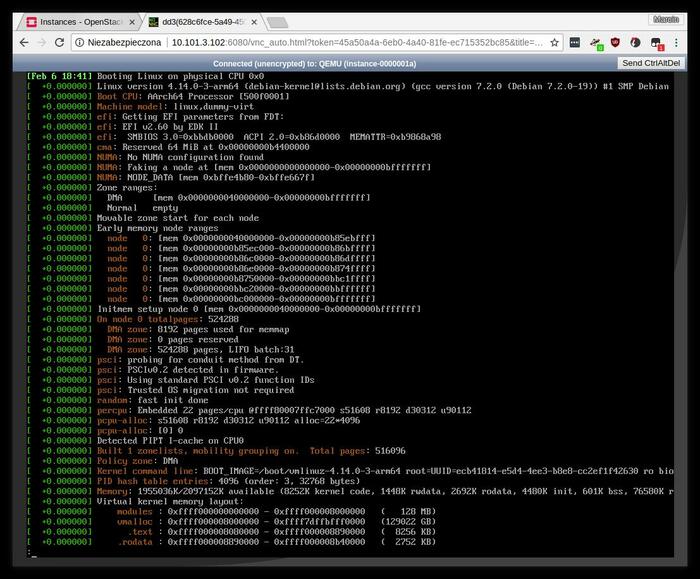During last week I was in Dublin, Ireland on OpenStack PTG. It was also the worst weather since 1982. There was snow and strong wind so conference quickly got renamed to SnowpenStack.
The main reasons for me to be there were:
- meet all those developers who took some time and looked at my changes
- discuss some other changes/plans
- share aarch64 knowledge with OpenStack projects
Conference took place in the Croke Park stadium. We used meeting rooms on 4th, 5th, 6th floors. One day by mistake I took wrong stairs and ended on top of the stadium in just T-shirt… Quickly ran to an elevator to get back to proper floor ;D

The schedule was split into two parts: Monday and Tuesday were for mixed teams sessions while Wednesday — Friday were for discussions in teams. I spoke with Kolla, Nova and Infra teams mostly. There were some discussions with Ironic, Kuryr and some other ones too. Also met several Polish developers so there was a time to speak in native language ;D
On Tuesday I went to the city centre to buy some souvenirs for family (and 99th fridge magnet for myself). Launched Ingress, did one mosaic to see more of a city and after 11 kilometres I was back at the hotel just in time for a small party in GAA museum. And then pub trip with Polish guys. When I finally reached the hotel (about 01:30) there were still discussions in the lobby and I took a part in one of them.

Team discussions started on Wednesday. Visited Nova one summarizing ‘Queens’ release. Turned out that it went better than previous ones. The main problem was lack of reviews — not everyone likes to pester developers on IRC to get some attention to patches. I was asked few times for opinion as I was one of few fresh contributors.
Kolla sessions were a bit chaotic in my opinion. Recently chosen PTL was not present and the person supposed to replace him got stuck at home due to weather. One of the discussions I remember was about Ceph: should we keep using our images or rather move to ‘ceph-ansible’ instead. Final idea was to keep as it looked like there were more cons than pros with moving to ‘ceph-ansible’ images.
Discussed Arm64 support with Infra team. We (Linaro) provided them resources on one of our developer clouds to get aarch64 present in OpenStack CI gates. Turned out that machines work and some initial tests were done. I also got informed that diskimage-builder patches to add GPT/UEFI support will be reviewed soon.
And then there were some weather related issues. On Wednesday every attendee got an email with information that Irish government issued the Red Alert which strongly suggest to stay inside if you do not really have to go outside. And as attendance was not mandatory then people should first check are they comfortable with going to Croke Park (especially those who not stayed in the hotel nearby). Next day organization team announced that the venue we used will close after lunch to make sure that everyone is safe. And the whole conference moved to the hotel…


Imagine developers discussing EVERYWHERE in a hotel. Lobby was occupied by few teams, Infra found a table in library corner, Nova took Neutron and occupied breakfast room. Bar area was quite popular and soon some beers were visible here and there. Few teams went to meeting rooms etc. WiFi bandwidth was gone… Some time later hotel staff created a separate wireless network for our use. And then similar situation was on Friday.
On Wednesday other thing happened too: people started receiving information that their flights are cancelled. There were some connections on Thursday and then nothing was flying on Friday. Kudos to hotel staff to be aware of it — they stopped taking external reservations to make sure that PTG attendees have a place to stay for longer (as some people got rebooked to even Thursday).
And even on Saturday it was hard to get to the airport. No taxi going to the hotel due to snow on a street. But if you walked 500 meters then cab could be hailed on a street. Many people went for buses (line 700 was the only working one). The crowd on the airport was huge. Some of those people looked like they lived there (which was probably true). Several flights were delayed (even by 4-5 hours), other got cancelled but most of them were flying.

Despite the weather sitting in a hotel in Dublin was safe, walking around too as there were about 15-20 centimetres of snow on a street. There were several snowmen around, people had fun playing with snow. But at same time local news were informing that 30 000 homes lacked electricity and some people got stuck in their cars. There was no public transport, no trains, no buses. Much smaller amount of people on streets.

Was it worth attending? Yes. Will I attend next ones? Probably not as this is very developer related where I spend most of my OpenStack time around building it’s components or doing some testing.
